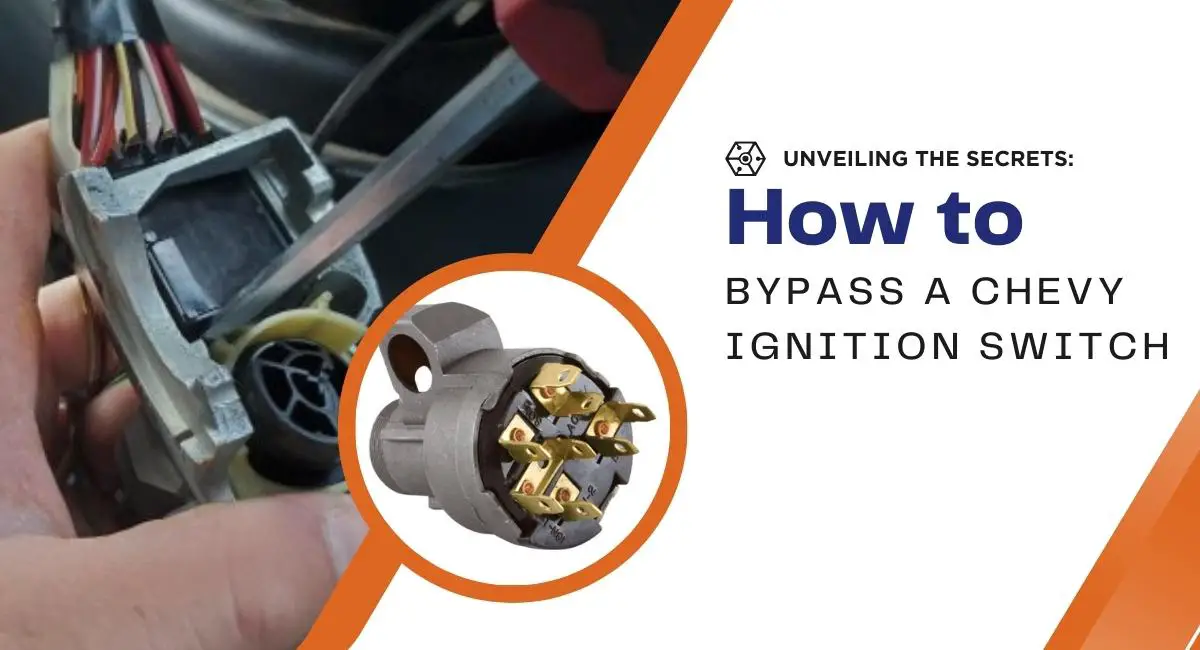In the world of automotive tinkering, certain tricks have piqued the curiosity of many car enthusiasts. When faced with ignition switch issues or emergencies, one such endeavor is bypassing the ignition switch in a Chevy vehicle.
So knowing alternative methods of bypassing the ignition switch can be valuable knowledge. While bypassing the ignition switch is generally discouraged and may be illegal, understanding different techniques can aid in troubleshooting and resolving ignition-related problems.
This article explores a few methods enthusiasts have studied, such as hot-wiring the starter relay, hot-wiring the ignition switch, removing the critical cylinder, using a screwdriver to turn the ignition, and other potential approaches.
Whichever method you select, here’s a guide to help you out!
Understanding the Ignition Switch
Before bypassing the ignition switch, it’s crucial to grasp its purpose and functionality. The ignition switch is responsible for activating the electrical components in a vehicle and initiating the engine’s starting process. It ensures that only authorized individuals can start the car, providing an essential layer of security.
The ignition switch typically comprises several positions: Off, Accessory (ACC), On, and Start. Each part serves a specific function. In the Off position, the switch cuts off power to the vehicle’s electrical components.
In the ACC position, power is supplied to accessories such as the radio and power windows. The On position powers the vehicle’s electrical system, including the fuel pump, while the Start position engages the starter motor to crank the engine.

Reasons for Bypassing the Ignition Switch
While bypassing an ignition switch is not recommended, there may be rare instances where a vehicle owner might consider doing so. Common reasons include:
- Ignition switch failure: If the ignition switch malfunctions, it can prevent the engine from starting. Bypassing the switch temporarily can help troubleshoot the problem.
- Emergencies: In emergencies, such as when the ignition switch is damaged during a critical moment, bypassing may be necessary to move the vehicle out of harm’s way.
- Repairs and diagnostics: Some car enthusiasts may want to bypass the ignition switch for diagnostic purposes or while performing repairs on the ignition system. This allows them to test components without relying on the switch.
Tools and Materials Needed
To successfully bypass the ignition switch, you may require the following tools and materials:
- Wiring diagram: Obtain a reliable wiring diagram specific to your Chevy vehicle model and year. This diagram will help you identify the necessary wires and connections.
- Wire strippers: These will be necessary for removing insulation from wires.
- Electrical tape: Use electrical tape to secure connections and prevent short circuits.
- Wire connectors: Connectors ensure stable and reliable electrical connections during bypass.
- Multimeter: A multimeter helps test electrical continuity and verify connections.
Methods of Bypassing the Ignition Switch
There are several methods available to bypass an ignition switch. One option is to hot wire the starter motor wiring behind the ignition switch or relay. Another approach involves removing the key cylinder and using a screwdriver to turn the remaining stub or forcefully inserting a screwdriver into the ignition switch to break it and gain access to turning the ignition on.
So, here are various ways of bypassing the ignition switch:
Bypassing the Ignition Switch by Hot Wiring the Starter Relay
One method of bypassing the Chevy ignition switch is hot-wiring the starter relay. This method directly connects the starter relay to the battery, bypassing the ignition switch’s control. This method is less intrusive, quicker, and more accessible but requires access to the engine bay and the owner’s manual specific to your vehicle.
It’s important to note that this method becomes more complex with newer cars due to the possible presence of a neutral safety switch or immobilizer, which cuts power to the starter motor rather than the ignition coil.
It is crucial to avoid using this method if your car has a steering lock that cannot be unlocked with the key. Furthermore, determining which terminal on the relay is battery positive and which is the starter motor positive can be challenging without a workshop manual or through some experimentation.
Here’s how it can be done:
- Locate the starter relay: The relay is typically found in the engine compartment’s relay box. Refer to your Chevy’s wiring diagram to identify the correct relay.
- Identify the necessary wires: Look for the wires connected to the starter relay. The primary wires include the battery power wire, the ignition switch wire, and the wire leading to the starter motor.
- Disconnect the battery: As a safety precaution, disconnect the negative terminal of the vehicle’s battery.
- Connect the battery power wire: Use a jumper wire to connect the battery’s positive terminal to the terminal on the starter relay that receives power from the battery. This effectively bypasses the ignition switch, providing direct power to the relay.
- Connect the ignition switch wire: Use another jumper wire to connect the terminal on the starter relay that receives power from the ignition switch to the terminal that activates the relay and engages the starter motor.
- Secure the connections: Ensure the jumper wires are securely connected and insulated with electrical tape to prevent accidental contact or short circuits.
- Reconnect the battery: Reconnect the negative terminal of the vehicle’s battery, completing the process.
Bypassing the Ignition Switch using Hot Wiring Techniques
Another method of bypassing the ignition switch on the Chevy truck is hot-wiring. This involves directly connecting the necessary wires. It’s important to note that this method may vary depending on the model and year of your Chevy vehicle.
The scene unfolds as the lower steering column trim is torn apart, and the ignition switch wires are yanked out and then scraped against each other, resulting in sparks that ignite the engine. While this method may work on certain cars, particularly older models, it won’t be effective on vehicles equipped with immobilizers.
Here’s a general outline:
- Disconnect the battery: As always, start by disconnecting the negative terminal of the vehicle’s battery for safety.
- Remove the ignition switch cover: Use a screwdriver or a suitable tool to remove the cover of the ignition switch, exposing the wiring and terminals.
- Identify the necessary wires: Refer to your Chevy’s wiring diagram to identify the cables associated with the ignition switch. These wires typically include the battery power you turn the ignition switch on, the starter, and accessory wires.
- Connect ires or appropriate connectors, connect the battery power wire directly to the starter and accessory wires, bypassing the ignition switch.
- Secure the connections: Ensure the jumper wires or connectors are securely connected and insulated with electrical tape to prevent accidental contact or short circuits.
- Reinstall the ignition switch cover: Once the connections are secure, reinstall the ignition switch cover.
- Reconnect the battery: Reconnect the negative terminal of the vehicle’s battery, completing the process.
Eliminate the Key Cylinder
Removing the key cylinder is another method that requires disassembling the ignition switch assembly and removing the key cylinder. It is arguably the safest option among the strategies mentioned, although it may require time and effort.
On the positive side, removing the cylinder will prepare you for installing a new one. Additionally, removing the cylinder will bypass the steering lock, which none of the previous methods accomplished.
However, it’s important to note that removing the critical cylinder will not bypass the immobilizer system, so you will still need the key for proper functionality. If you choose to obtain a new cylinder at this stage, expect to spend depending on your vehicle.
In the case of a car equipped with an immobilizer, you will also need to transfer the code from the old key to the new one. It’s worth mentioning that the immobilizer code reader is not integrated into the cylinder, so there should be no complications.
Here’s a general overview of the process:
- Disconnect the battery: Begin by disconnecting the negative terminal of the vehicle’s battery for safety.
- Remove the steering column covers: Using a screwdriver or the appropriate tools, remove the screws or clips holding the steering column covers in place. Carefully remove the covers to expose the ignition switch assembly.
- Locate and remove the ignition switch assembly: Locate the ignition switch assembly, which houses the key cylinder. Refer to your Chevy’s wiring diagram or the vehicle’s service manual for instructions on removing the assembly.
- Remove the key cylinder: Once the ignition switch assembly is accessible, locate the retaining mechanism that holds the key cylinder in place. Depress or release the mechanism (it may vary depending on the model), allowing you to remove the key cylinder.
- Connect the necessary wires: After removing the key cylinder, identify the essential wires that were previously connected to it. Use appropriate connectors or jumper wires to connect these wires, bypassing the key cylinder.
- Secure the connections: Ensure the links are securely connected and insulated with electrical tape to prevent accidental contact or short circuits.
- Reinstall the ignition switch assembly and steering column covers: Once the connections are secure, reinstall the ignition switch assembly and the steering column covers.
- Reconnect the battery: Reconnect the negative terminal of the vehicle’s battery, completing the process.
Risks and Consequences
It is important to note that bypassing the ignition switch without proper authorization is illegal in most jurisdictions. Such activities can have severe consequences, including legal penalties, voided warranties, increased insurance rates, and potential damage to your vehicle’s electrical system. Additionally, tampering with the ignition switch can compromise the security of your car, making it more susceptible to theft.
Always consult authorized professionals for any issues related to your vehicle’s ignition system. They possess the necessary expertise to diagnose and repair ignition switch problems without resorting to bypassing methods.
Conclusion
While bypassing a Chevy ignition switch is a topic of interest to some automotive enthusiasts, it is essential to reiterate that such actions are both illegal and potentially dangerous. Engaging in bypassing practices can have serious consequences, including legal repercussions and vehicle security risks. It is always advisable to consult authorized professionals for any issues related to your vehicle’s ignition switch or electrical system. Remember, tinkering with your car should be done responsibly and within the boundaries of the law. Stay informed, stay safe, and respect the integrity of your Chevy vehicle’s ignition system.
